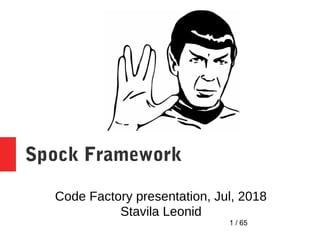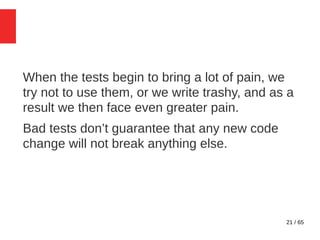The document discusses the Spock testing framework. It provides an overview of Spock, noting that it is a testing framework written in Groovy that embodies the behavior driven development (BDD) approach. Some key advantages of Spock are that it uses a more readable syntax compared to Java testing frameworks, has built-in support for stubs and mocks, and allows tests to be written in a given-when-then structure that resembles plain English.












![13 / 65
Working with a collection
Java:
List<Integer> results =
Stream.of(1, 2, 3)
.map(v -> v * 2)
.collect(Collectors.toList());
Groovy:
List results = [1, 2, 3]
.collect { it * 2 }](https://image.slidesharecdn.com/presentation-spock-180712164143/85/Spock-Framework-13-320.jpg)
![14 / 65
Example of filtering
Java:
List<Integer> evenNumbers =
Stream.of(1, 2, 3, 4).filter(v -> v %
2 == 0).collect(Collectors.toList());
Groovy:
List evenNumbers = [1, 2, 3, 4]
.findAll { it % 2 == 0 }](https://image.slidesharecdn.com/presentation-spock-180712164143/85/Spock-Framework-14-320.jpg)
























![39 / 65
Result with Unroll
maximum of two numbers[0] PASSED
maximum of two numbers[1] FAILED
Math.max(a, b) == c
| | | | |
| 7 0 | 7
42 false](https://image.slidesharecdn.com/presentation-spock-180712164143/85/Spock-Framework-39-320.jpg)

![41 / 65
Data Pipes
Right side must be Collection, String or Iterable.
where:
a << [3, 7, 0]
b << [5, 0, 0]
c << [5, 7, 0]](https://image.slidesharecdn.com/presentation-spock-180712164143/85/Spock-Framework-41-320.jpg)
![42 / 65
Multi-Variable Data Pipes
where:
[a,b,c] << sql.rows("select a,b,c from maxdata")
where:
row << sql.rows("select * from maxdata")
// pick apart columns
a = row.a
b = row.b
c = row.c](https://image.slidesharecdn.com/presentation-spock-180712164143/85/Spock-Framework-42-320.jpg)
![43 / 65
Ignore some variable
where:
[a,b] << [[1,2,3],[1,2,3],[4,5,6]]
[a, b, _, c] << sql.rows("select * from maxdata")](https://image.slidesharecdn.com/presentation-spock-180712164143/85/Spock-Framework-43-320.jpg)
![44 / 65
Combine data tables, pipes and
assignments
where:
a | _
3 | _
7 | _
0 | _
b << [5, 0, 0]
c = a > b ? a : b](https://image.slidesharecdn.com/presentation-spock-180712164143/85/Spock-Framework-44-320.jpg)














![59 / 65
Returning different values on
sucessive calls
subscriber.receive(_) >>> ["ok", "error", "error", "ok"]
subscriber.receive(_) >>> ["ok", "fail", "ok"] >> { throw
new InternalError() } >> "ok"](https://image.slidesharecdn.com/presentation-spock-180712164143/85/Spock-Framework-59-320.jpg)





